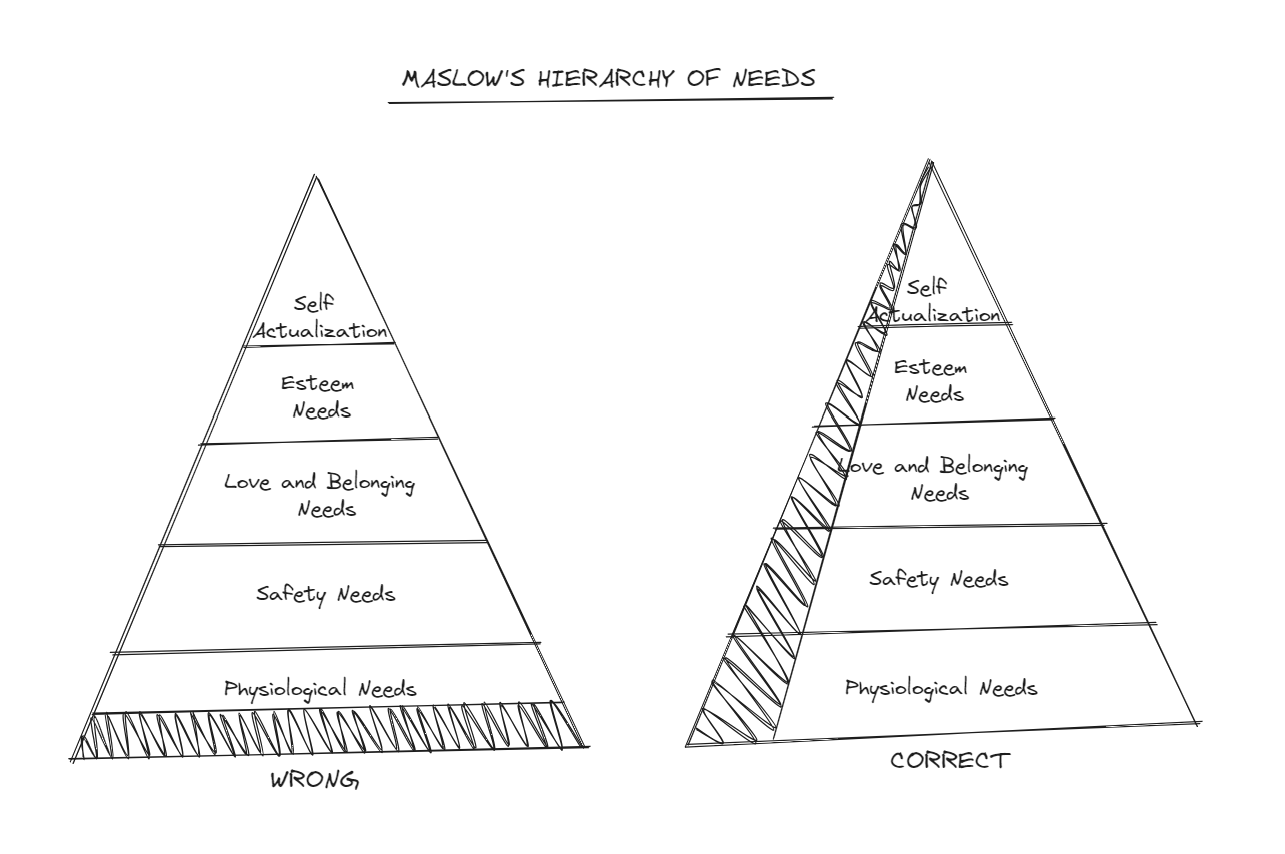Hierarchy of Needs ft. MVP
You may know I am obsessed with [[ metaphors ]] and how they help us build better [[ mental models ]] for life. This post is going to deal with one such metaphor — between the needs of an mvp
What is a product?
Where there is a problem, there is a product. —Me
A product comes into existence when its time arrives. It is essentially created to solve a problem, but it is different from any solution. A service-based company also solves problems of its clients, but not in the same way as a product-based company would do. The primary difference is that a product-based company creates a product that solves the problem at scale. Thus, a product can be defined as a productised solution that anyone can use with very minimal customization, as long as it is the same problem.
But not every solution can be a product because a product has to be standardized. Furthermore, the product needs to have certain features, to make the business viable.
Minimum Viable Product (MVP)
MVP is a product that has the minimum number of features that makes it viable for a business to run. It has four components:
- Functionality: It should solve the problem.
- Reliablity: It should consistently do so.
- Usability: It should be easy to use for the end user.
- Design: Its design should take user’s needs in consideration.

As you might have seen, some needs are more essential for product to function while others are good-to-have. The importance of these needs is in decreasing order from top to bottom. It needs to first solve the problem, then consistently do so. It should also do it in an easy-to-use manner, and give customer satisfaction at the end of the job.
The order of importance does not mean you focus on the first ignoring others, and them move onto the next one. That’s a wrong approach. If you ignore the other needs of the product, you may end up creating a product that solves the problem but only for you, and is not usable for others. Or it solves but breaks on the first go, and thus is not reliable.
Building MVP the Correct way!
Instead of solving one level at a time, the ideal way is to build all the levels simultaneously keeping all the needs in mind. However, the focus is more on functionality than reliability, and so on.
This can be understood by the slice made in the second diagram (shaded portion). Notice that it covers more area of the functionality need than the others. With every next cut (read product update), you will inch closer to a fully developed product, keeping every customer need in mind.

Maslow’s Hierarchy of Needs
Now, let us discuss Maslow’s hierarchy of needs. Maslow argues that human needs can be arranged in a pyramid like structure as shown in the following diagram.
He says that not all needs are equally needed. Some are more essential to life while others are good-to-have. A person first fulfils his most important needs, starting at the bottom and climbs up towards the top one-by-one.

Let’s pause for a second to see and reflect on how similar this pyramid is to the MPV pyramid we just studied.
- Both are pyramid structures of needs.
- Both have essential needs at the bottom and go to good-to-have needs at the top.
- If essential needs are not met, the product/human’s survival is at stake.
- Fulfilment of good-to-have needs add delight to the product/human development cycle.
Applying MVP model to Maslow’s pyramid
Why do we need to apply MVP model to Maslow’s pyramid?
Because same as an MVP, if you don’t keep all the levels in mind from the very beginning of the human life, you will be fulfilling the initial needs in such a way that they are incompatible with the later needs i.e. your later needs will become impossible to be fulfilled if you begin fulfilling the initial needs in the wrong manner.
Imagine, you are at the bottom of the pyramid and need food for your survival. If you choose to commit crimes like theft or robbery to afford food, you are risking your safety needs (i.e. the second level of needs).
Similarly, if you cheat on your business partners to make more money, your name gets tarnished in the media. Now, despite fulfilling the initial need, you can’t fulfil the next ones because it will become significantly harder now to find reliable partners or self-actualization.

Thus, you need to start fulfilling your needs in a healthy, ethical, and sustainable manner. Fulfilling one needs, keeping all other in mind at the same time. That’s the only way to live a purposeful, nobe, and satisfied life.
You may have heard this quote from Shahrukh Khan,
“Don’t become a philosopher before you become rich!” —Shah Rukh Khan
He meant that one should fulfil his essential needs first, then go after self-actualization. Otherwise, he may be ignored or face backlash.
I say, you do both—because that’s the only right way.
“Become philosopher before you become rich, but don’t preach it until you become rich!” —Me
if you are feeling existential crisis reading the last few lines, this may help you.